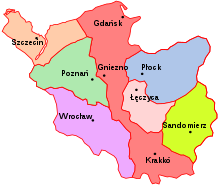
Back Феадальная раздробненасць Byelorussian Φεουδαρχικός κατακερματισμός Greek Feodaalne killustatus Estonian Ordini sociali feudali Italian Rozdrobnienie feudalne Polish Fragmentação feudal Portuguese Феодальная раздробленность Russian Феодальна роздрібненість Ukrainian
| English feudalism |
|---|
 |
| Manorialism |
| Feudal land tenure in England |
| Feudal duties |
| Feudalism |
Feudal fragmentation[1] is a process whereby a feudal state is split into smaller regional state structures, each characterized by significant autonomy, if not outright independence, and ruled by a high-ranking noble such as a prince or a duke.[2][3] Feudal fragmentation is usually associated with European history, particularly during the Middle Ages.[4][5]
Feudal fragmentation occurs after the death of the legitimate ruler leaves no clear heirs, and rulers of various subdivisions of the original state fail at electing or agreeing on a new leader for the previous, larger entity. In some cases (for example, the Holy Roman Empire), such a leader may be elected, yet wield much lesser powers than those of his predecessor. Feudal fragmentation is related to the concepts of agnatic seniority and principate.[3]

- ^ Piotr Górecki (2007). A local society in transition: the Henryków book and related documents. PIMS. p. 62. ISBN 978-0-88844-155-3.
- ^ (in Polish) Rozbicie dzielnicowe Archived 29 September 2012 at the Wayback Machine. WIEM Encyklopedia.
- ^ a b (in Polish) rozbicie dzielnicowe. PWN Encyklopedia.
- ^ Cite error: The named reference
FrankGills1996was invoked but never defined (see the help page). - ^ Grzymala-Busse, Anna (2024). "Tilly Goes to Church: The Religious and Medieval Roots of European State Fragmentation". American Political Science Review. 118 (1): 88–107. doi:10.1017/S0003055423000278.